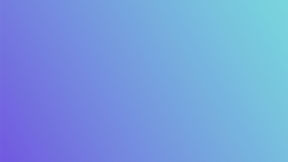The leading player of the last year has been without a doubt artificial intelligence 🤖, applied to many things, but standing out in the creation of amazing images. There has been no lack of funny, fantasy, futuristic images, memes, and, of course, deep fakes ⚠.
In the business of printing on-demand customized products, this has opened the doors to a whole new world for us 🌍. Like the colonizers of hundreds of years ago, we have ideas, dreams, and a lot of unknown ground to explore!
So we did a little bit of cartography, and created a map for you 🗺, to guide you in your first steps, and make the most of this technology.
Let’s start from the beginning!

How to write AI art prompts
We know that at the beginning you may feel like it's an impossible mission to write the idea you have in your head and have the AI give you back the picture you expected 🤦♂️. Believe us, we have tried many, MANY times. But with a little help and a bit of practice, you can become Tom Cruise and overcome any mission 💪.
Creating a nice image with artificial intelligence is both a science 🧪 and an art 🎨. We have to be detailed and patient. So let's take a look at some steps we need to follow:
✅ Define your vision: Start by defining what you want in your image. For example, if you want to create a sunset over a city, use "sunset over the horizon" as the core of your message.
✅ Think your art from the style: Guide the AI generator to the artistic style you want your image to have. Continuing with the initial example, let's say you want the city sunset to have a watercolor style. In this case, modify your prompt to the following: "sunset over skyline, watercolor style".
✅ Add extra details: Once you define your vision and style, it's time to add further details. In the case of the skyline over the city, are you interested in just skylines? Or do you prefer skylines in front of a mountain range? or a beach? Keep adding any extra details to your image to sharpen your prompt.
✅ Keep it simple: We know it seems contradictory when we're telling you to use details, but hear us out. While AI art generators have gotten much better at translating descriptions into images, they are not perfect. Too much text in your message can confuse an AI generator and lead to unexpected results. Focus on keeping instructions to the point for more predictable results.
✅ Experiment and iterate: It's possible that you won't be satisfied with the first result you get. Well, it's not possible, that's pretty much what will happen. You must keep iterating and changing small details to see how the AI results change. Play with the structure, words, and length of your prompt to see how each one affects the result.

Understanding these concepts and using them to your advantage will allow you to be better prepared to take advantage of all that AI generative art has to offer and help you create unique ideas and images that will help you maximize your print-on-demand business even further 📈.
Tips to make your prompts generate images from another planet
So far we have told you about the basic steps to build the best structure for your prompt. And, as we mentioned, the first result will not be your favorite, you will have to do some experimentation´👩🔬.
But let's pave the way a little more, shall we? How about some tips and best practices to help you go from crawling to walking?
Understand AI 🤖
To make the most of your prompts, it’s important to understand the capabilities of the AI applications you are using. These programs are trained using large databases of images and designed to mimic the styles found within that training data.
For instance, DALL-E and Midjourney gather their training data by scanning various sources on the internet such as social media posts, websites, forums, and image hosting sites. During the training process, images from the dataset are labeled with descriptive text, and then the AI generator is prompted to create similar images based on natural language prompts.
A separate program known as the discriminator determines when the AI generator has successfully produced an image that matches the given request.
When interacting with AI, it's important to use language that is similar to the data it has been trained and tested on. This often means speaking in the language of visual artists. You can request AI to use specific color schemes and mimic different artistic styles, such as realism, cubism, or expressionism. It can also produce works reminiscent of certain periods, like the Renaissance, Romantic era, or Victorian period. And if you have a particular artist in mind, you can ask AI to imitate their style, whether it be Pablo Picasso or Andy Warhol.
To create an image that shows your favorite city as if it were painted by Picasso, use specific terms from his style of art. Then you will also have the possibility to make some additions to it.
What if Picasso had thought of making cubist cartoons? 🤔
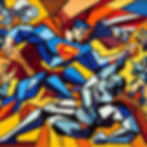
📌 Prompt: A comic-book-style image painted by Pablo Picasso in the cubist style of a superhero fighting a villain.
To enhance your creative process, consider using image generators alongside other AI tools. For example, you could use the famous ChatGPT as a prompt generator for your image prompts. Simply describe your desired outcome to the AI model and have it generate a brief description for your image generator.
Know the components of effective AI art prompts 🧩
Artificial intelligence can generate prompts using natural language, meaning you will enter plain text into the art generator. You can use complete sentences or even paragraphs, but many prompts consist of a list of phrases and keywords separated by commas for convenience.
Let’s see some examples! 👇🏻
What if we want to create a beautiful natural landscape? We can use a prompt like this: "Landscape with reflective water, sunrise in the background, and fall foliage."
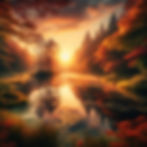
Now, let's say you want a Renaissance-style portrait. We should make sure to include this in the prompt. How about "A Renaissance style portrait, with a castle in the backdrop, and a blonde woman holding a baby in her arm"?

Tailor prompts for specific art styles 🖼
Make sure to include a description of the style you want your AI-generated art to have in your prompt. This information will guide the AI in choosing the best sources of inspiration to create your desired output.
You can specify particular art movements or styles, such as Surrealism, Impressionism, Expressionism, Cubism, or Minimalism. Selecting the right style will trigger the specific emotional response you want in viewers when they see your image.
➕Additionally, you can mention the names of famous artists to appeal to their particular styles, such as Van Gogh, Picasso, or Da Vinci.
So, let’s say you want something simple, you could go for a minimalist style.

📌 Prompt: "Minimalist style, circle shapes of different sizes, primary colors, full of life."
Do you like it? I don't 😅. But we can't deny that it honored what I asked it to do.
Now let's try something with animals. Animals are always a good idea, especially if we think of pet designs for our online store!
And let's pick an artist, which one is your favorite? I think I'm gonna go for Van Gogh. Yeah, let’s try… "Style Van Gogh, gorgeous Birman cat leaning on the window."
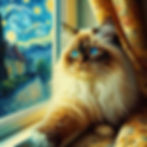
Now you are talking! I love this one. It's a shame I don't have a cat 😄.
Experiment with text and image prompts 🧪
Experimentation is key if you want to take full advantage of everything AI imagers have to offer. Yes, you can get beautiful results simply by trying a few times, but it's hard to get exactly what you're looking for without experimenting with the AI-generated images and the different prompts you can give them.
Like everything else, it takes flight hours 🛫. Sooner than you think, you'll be an experienced pilot 👨✈️.
For that, experiment with different words to see how they impact the final image. Try different descriptive text to see how it influences the output.
Instead of simply saying a couple in front of the river, you can write a prompt that says: "A couple holding hands watching a river, sunny day, trees around, birds in the sky."

But let's say you don't like that the birds are black (they look like crows, right?). Then, we can try the same prompt with some adjustments, such as "A couple holding hands watching a river, sunny day, trees around, seagulls in the sky."
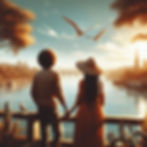
And so on, you can make modifications until you find the result you are looking for.
Use prompt engineering for high-quality results 🔧
You may be asking yourself, what the heck is prompt engineering? 😅 Don’t you worry, we're not going to dig deep here. Just what is necessary.
👉 Prompt engineering involves refining your text input to better guide AI in generating results that align with your desired outcome. By experimenting with various descriptors and AI generator options, you can customize the output to meet your specific needs.
This is what we said when we talked about adjusting image style and features, but it can also include incorporating different AI application features to further refine the results. Some Generative AI platforms like Leonardo or Midjourney have options to set up the results, like changing the aspect ratio, quality, or style.
It sounded scarier than it was, didn't it? 😄
Special mention here. A practice that you can take advantage of is reverse engineering. What is this? Well, it's basically the reverse process, as the name implies. Starting from an image and trying to find the most accurate prompt to recreate it.
It may seem like nonsense, but it will help you a lot when it comes to being creative and detailed with your future prompts.
How to do it? You have two alternatives. Do it by hand ✍, that is, take an image as a reference and start trying prompts with what you see in the image until you get close. Or use a tool such as CLIP Interrogator that does the work for you. Yes, it won’t get it at 100%, but would you?
So, remember the Van Gogh cat from before? ☝
CLIP Interrogator give us this prompt: "A cat that is sitting in front of a window, dramatic starry night sky, hyperrealistic fantasy art, ragdoll cat, looks like jerma985, perfect coloring, dream-like, cute art, Monet style, photo of a cat."
And the result was more than interesting. In fact, I like it better.
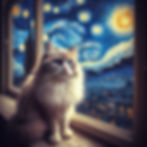
Leverage social media and Discord to get inspired 🤳
One of the best aspects of the world of AI art is its strong sense of community. Enthusiasts frequently share their creations and experiments online, using social media platforms like Discord. Lots of communities on this app are dedicated to digital art, where users can exchange their prompts and showcase the artwork they have created.
Additionally, browsing other users' prompts can provide you with the inspiration you need. The Midjourney app relies on Discord for generating art, allowing users to witness real-time art generation in their official Discord community.
🍒 Cherry on top, you can ask questions in these communities, and seek guidance from experienced users.
Where else can you find inspiration?
Neural Love’s Public Library
Websites like Lexica.
Playground’s Community Feed.
Prompts Examples
Let's see some more examples before we go!
📌 Prompt: A child playing on a sunny happy beach, their laughter as they build a simple sandcastle, emulate Nikon D6 high shutter speed action shot, soft yellow lighting.

📌 Prompt: Isolated convenience store in the middle of the desert at sunset, car parked outside, lo-fi, nostalgic.
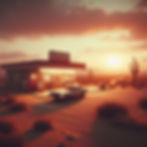
📌 Prompt: A woman with a strong determined attitude, a forest fire background, a close-up shot, realistic.
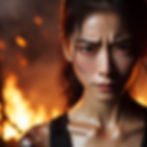
📌 Prompt: A futuristic hopeful busy city, purple and green color scheme.
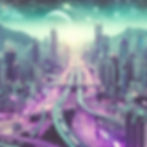
📌 Prompt: A photograph of three friends playing music on the street in the style of Pop Art.
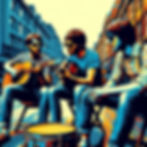
📌 Prompt: A group of dachshunds at a theater in a Renaissance style.
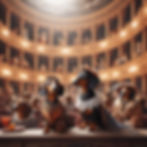
📌 Prompt: A portrait of a cyberpunk panda holding two flamethrowers, fantasy, elegant, digital painting, concept art, matte, sharp focus, illustration.
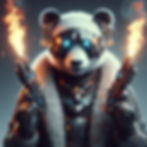
📌 Prompt: Pixel art scene with bright colors of a couple view from behind, he is tall with short blonde hair, she is short with brown with long curly hair. They are standing in New York, with a panoramic Central Park view in front of them.
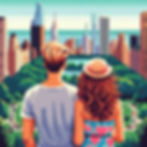
📌 Prompt: A colorful couple in Lego art. They are standing close to each other, she has long red hair, he has short brown curls, and they are wearing casual clothes, against a pastel purple and blue gradient background.
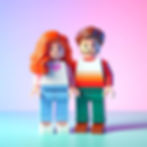
We could go on forever, it's been quite fun to try out prompts and see what happens, even if we rule out most of them.
The tree of creation 🌳
The title sounds a bit religious, doesn't it? 😅 But we actually mean a word tree to use in your prompts and create amazing images.
Along this article, we have talked about styles, perspectives, artists, and details that can help you create out-of-this-world images with AI. Well, here are 50 words to get you started that will be extremely useful! 🙌
portrait | Long exposure | blooming | transitioning | modern |
landscape | galactic | colorful | In action | retro |
standard | Lego art | Black and white | happy | scary |
Oil painting | abstract | Pixel art | sad | At the beach |
Steampunk style | HD | minimalist | crying | Living room |
cyberpunk | 4K | expressionist | laughing | dark |
Anime style | Bird’s eye | In the background | On canvas | light |
Picasso | Worm’s eye | foreground | Mona Lisa | foggy |
Andy Warhol | Wide shot | wrinkled | Vincent Van Gogh | sunny |
Salvador Dali | Close up | smooth | Renaissance style | raining |
These are just a few examples to inspire and guide you, but there are many words you can use to reinforce your prompts and guide the AI in the search for your best result.
We hope this prompt guide was able to teach you a thing or two about writing prompts for AI ♥. There is still a lot of ground to cover, but don't worry, we will continue to share content to pave the way for you 💪.
Remember that Customily is already integrated with OpenAi’s DALL-E 3, meaning you can sell personalized products with mind-blowing designs created with AI, letting your customer be the main character of the story and taking their creativity to another level 🚀
You can also learn more about this partnership here.
The best part is, that you can try it out and play for free!!
We have a 9-Day Free Trial! So, if you have a Shopify store or you are selling on Etsy, give it a try! You won’t regret it 😉
The future is here. And Customily holds the key 🗝
Happy customizing! ✨
*This is a third-party integration, you will need to have an account with Open AI to use it.
ABOUT THE PUBLISHER

Customily Product Personalizer is the best solution to sell personalized products, both in the e-commerce and the print-on-demand market. With the widest range of personalization tools, free clipart designs, realistic live previews that increase conversions, and printing files that help you automate your printing business; Customily is the ally you need to boost your profit margins in a high-competitive market.
Visit our website to learn more about us.
Or try it for FREE on Shopify.
